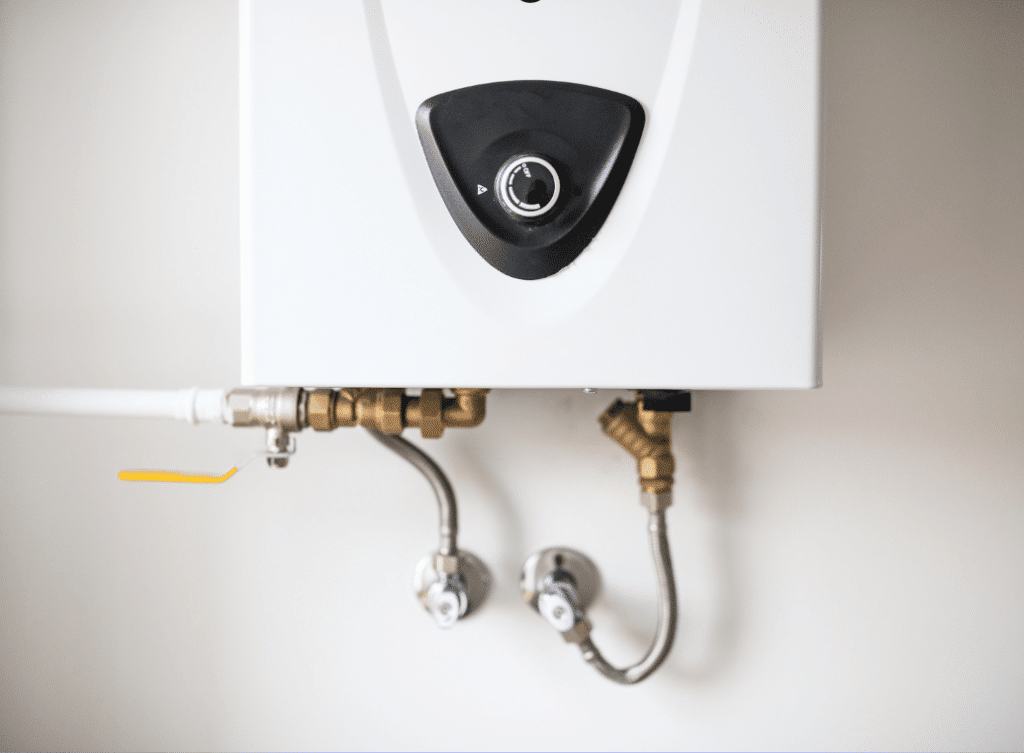
Maintaining your water heater isn’t as mystifying as it seems. Dive right into understanding how your water heater functions; whether it’s a traditional tank, tankless or a heat pump, each has unique maintenance aspects. Surprisingly simple tasks like flushing a storage tank to get rid of sediment or occasional descaling for a tankless unit could be just what your heater needs. Thus, becoming familiar with these integral details helps you target potential problems before they arise. Onward then, to knowing more about your own type of water heater.
One essential maintenance tip for a water heater is to regularly drain the tank to remove sediment buildup and improve efficiency. Additionally, insulating the tank can reduce energy expenses and extend its lifetime. It’s crucial to obtain professional inspection for more effective maintenance, as different types of water heaters may require specific maintenance methods tailored to their design.
Understanding Your Water Heater
Your water heater might seem like a big metal cylinder that heats water, but there’s more to it than meets the eye. It’s important to understand its basic functioning and the differences between various types of water heaters to ensure proper maintenance.
The most common types of residential water heaters are traditional storage tank water heaters, tankless (on-demand) water heaters, and heat pump water heaters. Each type has its own unique features and maintenance requirements.
Traditional Storage Tank Water Heaters:
- These are the most common type and are easily recognizable by their large storage tanks. They heat and store water at a preset temperature until it’s needed.
- Maintenance tip: Regular flushing is essential to remove sediment buildup and maintain efficiency. This involves turning off the water and power, attaching a hose to the drain valve, draining the tank, allowing it to cool, refilling it, and then turning it back on.
Tankless (On-Demand) Water Heaters:
- These units heat water directly without the use of a storage tank. They are more energy-efficient as they only heat water when it’s needed.
- Maintenance tip: Periodic descaling may be required to remove mineral deposits that can affect the heater’s performance.
Heat Pump Water Heaters:
- These systems use electricity to move heat from one place to another instead of generating heat directly.
- Maintenance tip: Inspect and clean air intake filters regularly to maintain proper functioning.
Understanding these specifics about your specific type of water heater will guide your maintenance efforts. For instance, knowing that a storage tank heater requires regular flushing helps you prevent sediment buildup and potential damage to the tank, while being aware of the need for periodic descaling in tankless heaters helps maintain their efficiency.
By being informed about the different types of water heaters and their unique maintenance requirements, you’ll be better equipped to anticipate potential issues before they occur. This proactive approach can save you time, money, and inconvenience by preventing major breakdowns or malfunctions.
Armed with this understanding, let’s advance to discussing essential maintenance tasks for your specific type of water heater to ensure its optimal performance and longevity.
Regular Inspection and Cleaning Methods
Carrying out regular inspections on your water heater can make a big difference in ensuring its efficient performance and longevity. It’s always best to catch any problems early, before they turn into larger issues that may be more complex and costly to resolve.
When you regularly inspect your water heater, you’re essentially keeping an eye out for any warning signs that something might be wrong. This includes checking for leaks, which can signal a problem with the tank or its connections. If you notice any corrosion on the tank or unusual sounds coming from the heater, it’s crucial to address these issues promptly. Addressing these early indicators can prevent more serious and expensive problems down the line.
For instance, if there’s a small leak, it might just be a minor issue like a loose connection. But left unattended, it could result in major water damage and potentially lead to the need for a complete water heater replacement. By conducting regular visual inspections, you’re giving yourself the opportunity to catch these small problems before they escalate.
Apart from visual inspections, draining and flushing your water heater on an annual basis is another indispensable maintenance task. Over time, sediment buildup occurs inside the tank, which can compromise the efficiency of the unit and shorten its lifespan.
Flushing your water heater involves turning off the power and water supply, attaching a hose to the drain valve at the bottom of the tank, draining it to remove the sediment buildup (which typically appears as muddy debris), allowing it to cool, refilling it once clean water starts flowing out of the hose, and finally turning it back on.
By conducting these essential maintenance tasks diligently, you’ll not only ensure that your water heater works optimally but also minimize unexpected breakdowns and repair costs down the line.
Situation-Based Maintenance Tasks
Water heaters may require specific maintenance based on differing circumstances, such as adjusting the temperature and testing the pressure relief valve. Although these tasks may seem daunting initially, they are critical for the functionality and safety of your water heater.
Temperature Adjustment
When it comes to adjusting the temperature of your water heater, most households find that setting it to around 120°F works well. This not only saves energy, keeping your utility bills affordable, but it also reduces the risk of scalding from excessively hot water. Lowering the temperature also helps in preventing burns, especially in homes with children or elderly individuals.
It’s important to remember that while lower temperatures are great for saving energy, you don’t want to set it too low to prevent bacteria growth. Water heated below 120°F may not be hot enough to kill bacteria like Legionella, which can be harmful if present in your water supply. So, finding the right balance between energy savings and bacteria control is crucial when adjusting the temperature of your water heater.
Pressure Relief Valve Testing
The temperature pressure relief valve in your water heater is a critical safety component. Periodically testing this valve ensures it’s functioning properly, which is essential for preventing dangerous pressure buildup.
To test the pressure relief valve:
- Place a bucket beneath the discharge pipe connected to the valve.
- Lift and then release the lever on the valve.
- Watch for water to flow out of the pipe, and ensure that it stops flowing when you lower the lever.
- If no water flows out or if the flow doesn’t stop when you lower the lever, this indicates a problem with the relief valve that needs immediate attention from a professional plumber.
These simple tests and adjustments might seem small but go a long way in ensuring that your water heater runs efficiently and safely for years to come.
As we explore more situation-based maintenance tasks for your water heater, these small yet impactful measures will help extend its lifespan and ensure safe operation.
When and How to Replace Parts
The components inside your water heater work hard to provide you with hot water, but they don’t last forever. If not properly maintained, some of these parts can deteriorate over time, causing the entire system to malfunction. Dive into the details of when and how to replace these critical parts.
Protecting Your Tank
The anode rod is like a guardian angel inside your water heater tank. Its job is to protect the tank from corrosion by attracting corrosive elements. As it does so, the anode rod itself corrodes over time, sacrificing itself to save the tank. It’s recommended to replace the anode rod approximately every 5 years. Neglecting to replace it could lead to corrosion within the tank, resulting in leaks or even a burst tank—a costly disaster that could have been easily prevented.
The good news is that replacing the anode rod is relatively simple if you know what you’re doing. Simply turning off the water and power, draining the tank, removing the old rod, and installing a new one will ensure your water heater’s longevity.
Air Intake Filter Replacement: Keep It Breathing Easy
For tankless water heaters, maintaining proper air intake is crucial for its smooth operation. Regularly replace the air intake filters to prevent dust and debris from clogging the system. This will help ensure efficient heating and extend the lifespan of the unit.
Think of it as ensuring clean air for your heater – easier breathing means better performance and less wear and tear on internal components.
By understanding when and how to replace these essential parts, you’ll be taking proactive steps toward extending the life of your water heater and preventing costly malfunctions down the line.
Understanding how to maintain your water heater at a component level can mitigate unwanted breakdowns. Let’s now move on to explore professional services that can further ensure the longevity and efficiency of your water heater.
Professional Water Heater Services
While you might be proactive in maintaining your water heater by yourself, there are certain tasks that benefit from professional attention. Anode rod replacement and tank flushing are two such examples. An anode rod is a crucial part of your water heater, protecting the inside from corrosion. Over time, this rod gets used up and needs to be replaced. A professional plumber can accurately assess the condition of the anode rod and replace it when necessary, ensuring the longevity of your water heater.
Additionally, flushing the tank is a critical maintenance task that requires skill and attention to detail. Sediment buildup can corrode the inside of your water heater and reduce its efficiency. By entrusting this task to a professional plumber, you can be confident that it will be done thoroughly and effectively, preventing unexpected breakdowns and extending the lifespan of your water heater.
Extending Lifespan and Preventing Breakdowns
By enlisting the services of a professional plumber for water heater maintenance, you’re not only investing in the longevity of your system but also enjoying peace of mind knowing that potential issues are being addressed by experts. This can potentially extend the lifespan of your water heater by 3-5 years, ultimately saving you money in the long run.
In summary, seeking professional water heater services ensures that specialized tasks are carried out efficiently based on the type of water heater you have. This approach not only prolongs the life of your water heater but also minimizes unexpected breakdowns, providing you with reliable hot water when you need it most.
Maximizing Your Heater’s Efficiency
Just like any hard-working device in your home, your water heater deserves some love to keep it running as efficiently as possible. Let’s start by talking about insulation. Insulating both the water heater tank and the connected pipes does a lot more than just save energy expenses.
In colder climates, insulating the pipes connected to the water heater goes beyond just energy efficiency—it also protects against freezing and potential burst pipes. Just like packing a snow jacket when you expect chilly weather, insulating pipes is a smart preventative measure against the harsh cold.
The insulation acts as a barrier against extreme temperatures, ensuring that your pipes remain functional even in freezing conditions. This is particularly crucial during colder months when untreated pipes are vulnerable to freezing, which can lead to major inconvenience and costly repairs.
By insulating both the water heater tank and connected pipes, not only do you make significant strides in reducing energy expenses, but you also safeguard your system from potential damage caused by freezing conditions.
Taking these steps for proper insulation will not only save you money on energy bills but also protect your water heating system from potential damage due to freezing conditions. Don’t wait until it’s too late—take action now and contact Santos Bros Plumbing to ensure your water heater is efficiently insulated.

